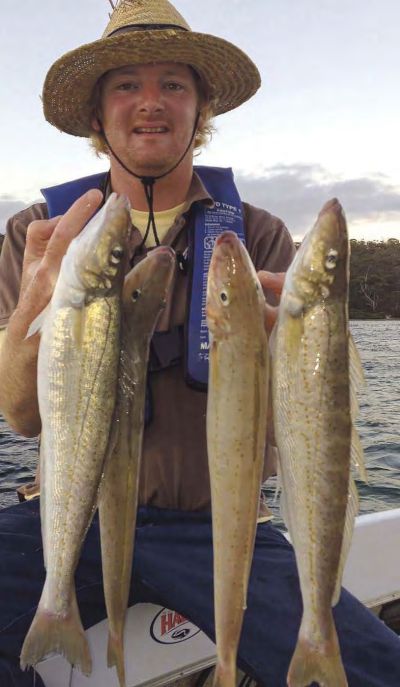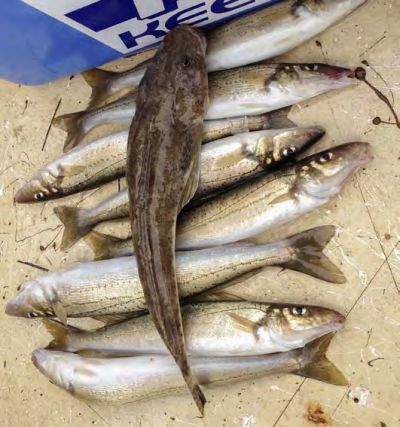 Presented from Issue 107, December 2013
Presented from Issue 107, December 2013
If someone had suggested to me 10 years ago that we would experience ‘whiting fever’ and see anglers catching King George whiting up to 60cm long in Tasmania I would have put it down as a bit of wishful thinking — I guess things change.
Here is a typical scenario in my shop as November approaches. I am in my Tackle Shop working as usual when the phone rings.
Me: Good morning this is St Helens Bait and Tackle.
Caller: Hi, me and a few buddies are heading down on the weekend and wondering if the KG whiting are running?
I don’t get ‘do you ever catch any?’ or ‘are there whiting in the bay?’ Now there is the expectation of a whiting season every year and I am receiving call, after call, after call.
This is great news for Tasmanian anglers and an indication of just how amazing our salt water fishery is down here, particularly on the East Coast. I am now regularly having interstate visitors exclaiming that Georges Bay, St Helens is one of the best estuaries in the southern half of Australia, and when I tell them they can also catch King George whiting they are just amazed.
 The Fish
The Fish
The King George whiting, or Sillaginodes punctatus, sometimes also known as the spotted whiting is predominantly a coastal marine fish and is a member of the smelt-whitings family.
The KGW inhabits the south coast of the country from southern Western Australia right through to New South Wales and as far down as North East Tasmania.
Flinders Island has always been known locally as a bit of a hot spot as far as Tasmanian is concerned and has certainly produced some very large fish to date.
The KGW can grow to a length of 72 cm and 4.8kg in weight and is distinguishable from other species of whiting by its unique pattern of spots, as well as its elongated shape. The King George whiting forms the basis of one of southern Australia’s most important commercial fisheries, reportedly worth over five million dollars per year.
There is very little known about the KGW movements in Tasmania, however generally speaking, spawning takes place in April through June in mainly offshore areas. The larvae end up in the coastal estuaries with the aid of water currents and tides and during the summer months, when water temperatures warm up, growth is quite rapid with most fish reaching a size of about 28cm at about two to three years old.
By the time the fish have reached 35cm they can be up to three to four years old and at this stage start to move out from the bays, progressively moving into deeper offshore waters as adult fish. They live to fourteen to fifteen years.
Locations
So far there seems to be a handful of hot spots around the state that are producing regular catches every year now of quality King George whiting. As mentioned earlier Flinders Island has been high on the list for many years but more recently more easily accessible locations have started to see seasonal populations of KG whiting. These include Georges Bay St Helens, Ansons Bay, Bridport, Low Head and the Smithton area.
One thing all these places seem to have in common is the size and quality of the whiting being caught, they are mostly large hard fighting fish, the smallest I have seen have been around 35cm in length and right up to almost 60cm, excellent fish even by South Australian, Kangaroo Island standards. One key factor I have learnt quickly while targeting King George whiting in Tasmanian Estuaries is the specific location in which the fish chooses to feed, if you are not right in the zone you will not be successful in catching the KGW.
What the angler needs to look for are areas of some current flow, either in or adjacent to a channel, where there are patches of sand or shelly bottom in amongst patches of broken weed or weed beds, anywhere there are good shellfish beds close by is even better. The KGW will sit in schools just off the edge of the weed in the current and pounce of food items being stirred up flowing past them.
In order to consistently hook these fish you must place your baits right in the little area a foot or two from the weed edge. If you hit the right zone the result will be an almost instant bite and hopefully a hookup, if you find yourself too close to the weed leatherjacket and wrasse will be the dominant species and too far out onto the sand will generally see a long wait between fish.
If you start to look closely at your local waterways you will start to see the type of environment described above is quite common, you too may have a good population of KGW right under your nose and didn’t even realise. Many estuaries around Tasmania’s coastline are starting to produce King George whiting and new grounds are being discovered as each year goes by.
 Techniques and Tackle
Techniques and Tackle
Here is where the old school style of rods really come back into vogue, I favour a longer rod of 7-8 foot with a soft tip action, a nibble tip style is perfect. The KGW have a very quick but subtle little bite so fast action stiff rods don’t allow the fish to be able to grab the bait without feeling to much resistance and letting go. A nice soft light weight tip allows the fish the scoff the bait and lets the angler detect the take, a classic nibble is what we are talking about here so sensitivity in a rod tip is the key. Reels in the 1000- 2500 size spooled with some supple 6-8lb monofilament or a light 3-4lb Braid will compliment the rod and handle any KGW thrown at them.
My personal outfit at the moment consists of a 7’6” Shimano Bushy Bait Legend Whiting rod coupled to a Shimano Stradic Ci4 3000 and spooled with some 5lb Power Pro bite motion braid. The soft action and sensitive tip of this rod is perfect for detecting and then allowing me to react to the take quickly. The KG Whiting dont muck around, they hit the bait quickly and often all you get is a very fast “rat-tap-tap” and it will have stripped a whole pippie from the hook so you need to feel the bite immediately and react to it.
Wilson Surecatch make a pre-made “tangle free Whiting rig” that is perfect for Tassie waters. Its ideal for use in deep or shallow water, fast tides and is the perfect rig for those times where the KGW can be touchy. It is a simple running sinker rig with a small sinker attached to a trace with a ring or swivel at the other end running down the main line to another swivel to stop it. I find small bomb style sinkers are best suited and only ever use just enough weight to get the rig to the bottom but still allow some natural movement; you don’t want to anchor the rig to the bottom. This style of rig allows you to change the sinker weight to suit the conditions without having to change the whole rig
This rig allows the bait to move around naturally in the current attracting their attention and getting them to bite, it also allows the fish some room to move and play with the bait, before a good hookup occurs. As with any rig, you should also consider allowing your trace to be slightly heavier or stronger than your main line and another little trick is to put a small red bead on top of the hook for added attractiveness.
The baits need to be tossed right into the “Hot Zone” discussed earlier and stay in touch with the bait as soon as it hits the water, once the bait hits the bottom provided you are on the fish they will be on the bait almost immediately so be prepared for a fast, quick nibble type bite and strike quickly but not too violently, you don’t want to pull the hook from the KGW small mouth.
KGW will eat a wide range of baits but prefer worms, yabbies, prawns and without a doubt their favourite Pippies (Cockles).
To catch KGW the angler must make the effort to have premium bait, bloodworms and beach worms are difficult to find in Tasmanian waters however Dynabait do a Freeze Dried series of worms in Bloodworm, Sandworm and Tubeworm. They can be kept in your tackle box and only need a few minutes of rehydrating in some water to leave you with a quality top rate KGW bait. I found the Pippies were also a favourite as were the King Bait Squid Strips.
Successful fishing for this particular species however does require the angler to be actively involved, you need to be on the ball and react swiftly to the fish hitting the bait. Just casually baiting the hook, sticking the rod in the rod holder and sitting back waiting will not produce the fish. Take care baiting up, check the rig is correct and not tangled, make sure the sinker is just enough to keep it on the bottom not anchored, stay in touch with the line tight and strike quickly at the slightest indication of a rattle……even then you will still miss a lot of takes as the KGW are fast at pinching a bait.
People constantly ask me when the best times to fish for Whiting are, I have found that water movement is of utmost importance be it an outgoing or incoming tide. The moving water dislodges food items and scours the sandy bottom allowing the fish to pick off tasty morsels. It’s a case of studying the location and positioning yourself to take advantage of the tide movement, I have caught fish on both tide directions just in different locations so be prepared to move around and don’t fall into the rut of staying in the “magic hole” that everyone wants to find. King George whiting are a hard fighting, fantastic table fish and are able to be caught by anglers of all ages. We are seeing them turn up in more and more locations every year and in strong numbers.
I am sure there are many theories flying around as to why they have started to appear in better numbers, whether this is due to water temperatures or “climate change”, a reduced effort in commercial pressure and recreational netting in our bays and estuaries or just simply anglers using better fishing tackle and techniques to target specific fish species…..who knows.
What I do know is that Tasmania is fast adding another great species to its ever growing list of fantastic fish and, I hope will continue to prosper and we as anglers can help this by limiting our catch.
I have a rule on my boat and that is I limit everyone to a maximum of five whiting each, the rule book may allow for more legally but we don’t know enough about this fishery or the fish to sit back and watch large bags being caught. Help look after the fishery and ensure we have strong numbers of KG whiting to catch in the future and only take a few fish for an immediate feed, limit your catch not catch your limit.
Jamie Henderson
